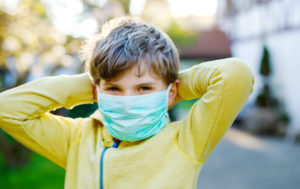For the last several weeks in West Virginia, we’ve seen a slow increase of the number of COVID-19 cases in the 0-19 age group as reported on the WVDHHR’s COVD-19 dashboard. As of 10am this morning, children under 19 account for 12.98 percent of all cases in our state.
For context, between January and May, children in the United States accounted for 5 percent of active cases.
The number of pediatric cases around the country is increasing. According to Kentucky’s and Virginia’s dashboards, their active COVID-19 cases for this demographic are between 10 and 11 percent. Lexington saw 21 new cases in children under the age of 18 over the weekend. And in Florida, state data show that children there have a 31.1 percent positivity rate for COVID-19 infections.
In a recent NPR article, the chief of the Division of Pathology and Lab Medicine at Children’s National Hospital in D.C. said that while these increasing numbers might be surprising, they could be due to the fact that children haven’t been a focus of testing. Much of the early testing focused on those who were older and exhibited symptoms and required a doctor’s order.
 We’ve seen the testing rate of this demographic increase on our state’s dashboard, too. Nearly 8 percent of those tested are ages 19 and younger. This is a good thing; perhaps we should commend our state for testing more kids. Imagine if we were still under the assumption that kids only accounted for 5 percent of all cases, then reopened schools and began screening and testing as some counties are planning. It would appear as if the school setting was the major source of virus transmission, when COVID-19 cases had been increasing for months.
We’ve seen the testing rate of this demographic increase on our state’s dashboard, too. Nearly 8 percent of those tested are ages 19 and younger. This is a good thing; perhaps we should commend our state for testing more kids. Imagine if we were still under the assumption that kids only accounted for 5 percent of all cases, then reopened schools and began screening and testing as some counties are planning. It would appear as if the school setting was the major source of virus transmission, when COVID-19 cases had been increasing for months.
What our state doesn’t track, and many other states don’t, either, is the number of hospitalizations by age. We do know that the number of pediatric deaths due to COVID-19 is low. According to the CDC, 228 children and teens through age 17 have died in the United States due to COVID-19. For context, more than 138,000 Americans have died in total to date, and 3.6 million have contracted it. This year in the U.S., 166 children died of the flu during flu season.
This may be somewhat reassuring to those of you worrying about sending your child to school in September. For you, there’s more promising news. Previously, experts had posed that kids could be viral spreaders, or “super spreaders.” A new study from South Korea suggests that children 10 years and younger transmit the disease much less often than adults. For children older than 10 years, they can spread the virus as least as well as adults.
And so, I said all that to say this: Perhaps the experts and media were too quick to jump to the conclusion that COVID-19 isn’t a “kids’ disease.” We’ve noticed increased traffic on our COVID-19 webpage as the numbers of pediatric cases in our state have increased, which means a number of West Virginia’s parents and caregivers are looking for more state-specific information.
If you’re one of them, I strongly suggest you bookmark this webpage, weight your sources of information, and take stock that in a number of other countries, kids have already gone back to school with continuing low infection rates. Just last week, a German study showed low coronavirus infection rates in their schools, which resumed in May.
That can happen here, too. But first, we will have to drastically reduce infection rates. And we should focus more on collecting and analyzing state-specific data.




2 Comments
Cindy Fitch · July 23, 2020 at 12:13 pm
This is great information for parents, Kelli. Thank you. Parents need to have science-based data to make an informed decision about whether to send their children to school or continue to teach them at home. Both options have risks and benefits to consider.
Kelli · July 26, 2020 at 3:21 pm
Completely agree. I just read today that the largest demographic of active cases in WV are in the 20-29 age demographic– also the largest demographic of young children in our state. And so, we should be focusing on educating parents on the basics of stopping the spread, too.